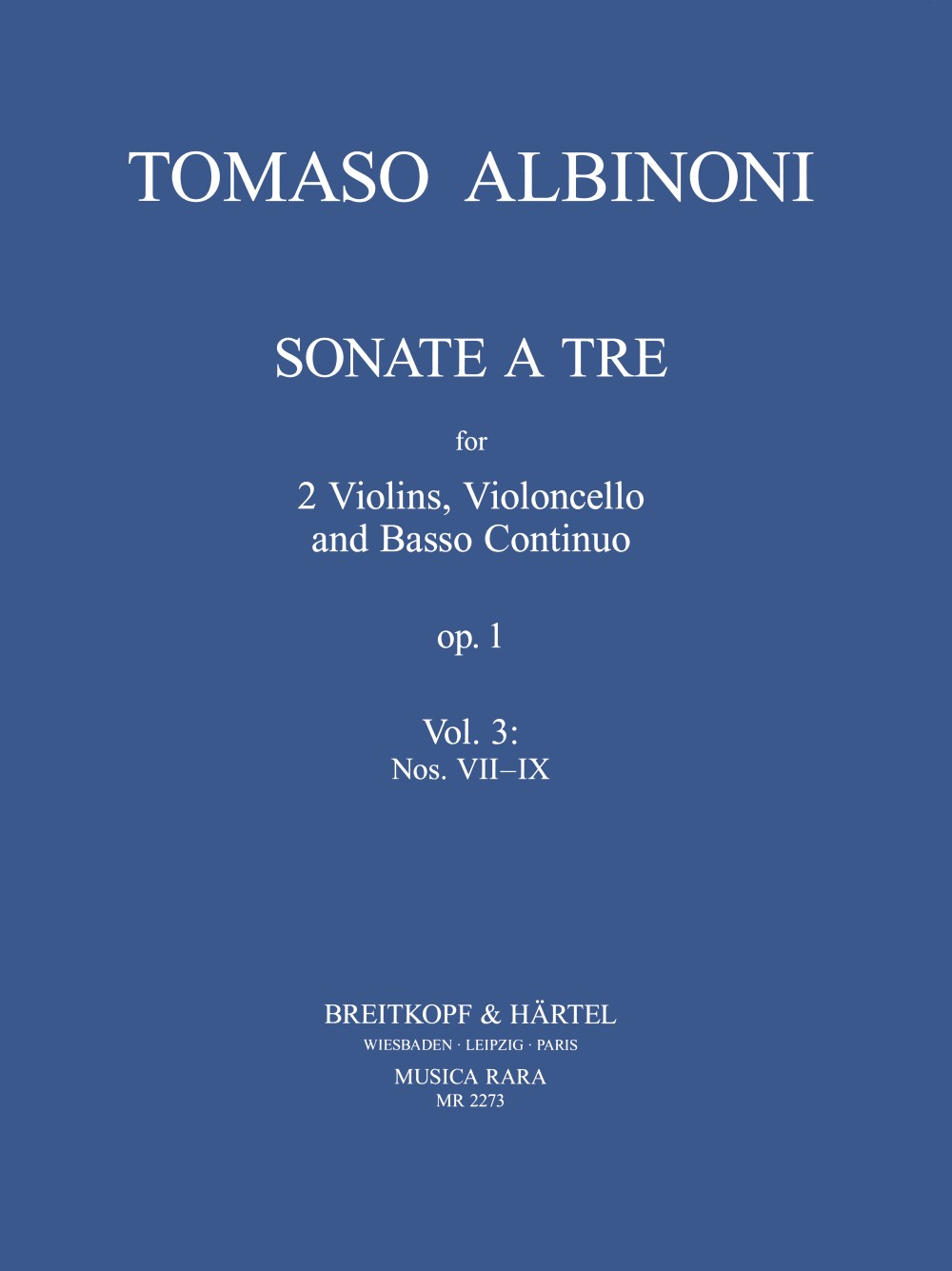
BREITKOPF & HARTEL - 15131
Albinoni 3 Sonatas from Opus 1
Composer: Tomaso Albinoni
Publisher: Breitkopf & Härtel
Instrumentation: Mixed
Format: Chamber Parts
Binding: Softcover
Dimensions: 9 in x 12 in
Pages: 76
Albinoni 3 Sonatas from Opus 1
Juilliard Store
144 West 66th Street
New York NY 10023
United States
Choose options
Albinoni 3 Sonatas from Opus 1
Juilliard Store
144 West 66th Street
New York NY 10023
United States
Albinoni 3 Sonatas from Opus 1
Juilliard Store
144 West 66th Street
New York NY 10023
United States
Sonatas Nos 1-3
Tomaso Albinoni's Trio Sonatas op. 1 enjoyed enormous popularity from the moment they were released, as can be seen in the numerous reprints and Johann Sebastian Bachs own use in the harpsichord fugues BWV 946, 950 and 951. The state of the sources is ideal for a well-grounded edition: the partbooks of the first edition of 1694 provide a secure foundation on which Martin Lutz worked out a musical text that, compared with other transmitted sources, provides a reliable basis.
Preface:
With the publication of a collection of trio sonatas as his op. 1 in 1681, the young Corelli helped turn the four-movement form of the sonata da chiesa into a classic that became a kind of gold standard against which every successive composer had to measure himself with his own op. 1 trio collection. Thus Tomaso Albinoni’s op. 1 (Venice: Sala, 1694) takes ist place within an illustrious society consisting of Torelli’s “Suonate a tre, opera prima” of 1686, Veracini’s op. 1 of 1692, Caldara’s of 1693, some trio sonatas by Vitali, also of 1693, and other collections that were soon to follow, such as Gentili’s of 1701, Vivaldi’s of 1705 and Reali’s of 1709. All these collections were printed in Venice, which was then the leading center of music publishing.
Albinoni’s first twelve sonatas enjoyed a broad dissemination in their day. Substantiating this are, on the one hand, pirated editions from Amsterdam (1698) and a reprint of 1704 by Sala, as well as, on the other, the borrowing of three fugal subjects (from the second movements of the third, eighth and twelfth sonatas) by no less a master than Johann Sebastian Bach, who unleashed the true potential of these themes in his harpsichord fugues BWV 946, 950 and 951. Albinoni’s fugal pieces show a greater interest in the melodic aspect than in contrapuntal refinements, so much so, in fact, that in 1975 a specialist such as Eleanor Selfridge-Field spoke of a “diluted fugal concept.”
Nevertheless, these sonatas, which are still closely bound to the fourmovement structure established by Corelli, contain rousing and highly effective rapid movements as well as harmonically refined and euphonious slow movements (as is impressively confirmed by the “Parnassi musici” ensemble’s complete recording of 2003 on cpo). In this light, it is thus all the more amazing that there has not yet been a complete edition of Albinoni’s op. 1, and that not all of the editions of the individual sonatas, published decades ago, are still available today.
The first two volumes of our complete edition of Albinoni’s op. 1 followed the first edition (Giuseppe Sala, Venice, 1694; second, unchanged printing: 1704). For the third and fourth volume, we were able to consult two further sources: the part books published by Estienne Roger (Amsterdam c. 1710) as well as manuscript part books from the collections of the Saxon Court Chapel (Schranck No: II, 1. Fach 2. Lage, today in the Sächsische Landesbibliothek – Staats- und Universitätsbibliothek Dresden).
A comparison of the sources shows that Roger follows the Venetian first edition (a few characteristic printing errors were reproduced). The Dresden parts present a similar situation. Whereas the 1694 print was made with movable characters and thus had no beaming of note groups, the copper-engraved Amsterdam print and the Dresden manuscripts both have beaming. This is not made according to any truly logical principle, however, and is inconsistent. This is why we set the beams according to present-day usage in our new edition.
Our edition also fundamentally reproduces the figuration of the first edition. The occasional displacement of thoroughbass figures was corrected without comment. The first edition (and the later sources based on it) proceeds from the assumption that the continuo player will supply the accidentals whenever they can be deduced from the context. The same also often applies to sixth chords. The thoroughbass realization has taken this into account. The figuration diverges a few times from the harmony heard in the violins; we continue to follow the source here, while providing the correct harmony in the realization.
We are aware that the “realization” or laying-down in writing of the basso continuo (which is ultimately a profoundly improvisatory art form) is actually quite preposterous and even quite restrictive for the player, who all too easily understands it as “printed music that must be played in this form.” Nevertheless, in our figured-bass realization, we wish to provide an idea of the harmonic activity that can be comfortably grasped by the less experienced player. This can serve as a starting point for one’s own elaboration, which can then react sensitively and imaginatively to the paradigms of instrument (organ or harpsichord), space and performance style of the strings.
